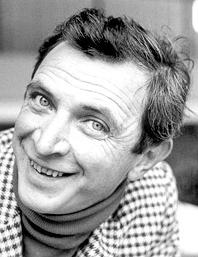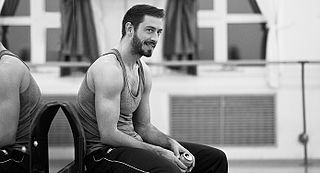Related Research Articles
Georgette is a feminine given name, the French form of Γεωργία (Geōrgia), the feminine form of George.

John Cyril Cranko was a South African ballet dancer and choreographer with the Royal Ballet and the Stuttgart Ballet.

Stuttgart Ballet is a leading German ballet company. Dating back to 1609, then the court ballet of the dukes of Württemberg, the modern company was founded by John Cranko and is known for full-length narrative ballets. The company received the Laurence Olivier Award for Outstanding Achievement in Dance in 1981.
Richard Holden was an American dancer, choreographer, choreologist, teacher, musician and writer.
Eduard Greyling is a South African ballet dancer, now retired. After an illustrious career as a principal dancer with CAPAB Ballet in Cape Town, he became well known as a dance notator, teacher, journalist, and critic.
Maria Eichwald is a Kazakhstani ballet dancer who has settled in Germany.
Kang Sue-jin is a South Korean ballerina. She is a principal dancer at Stuttgart Ballet.

Georgina Parkinson was an English ballet dancer and ballet mistress. She joined The Royal Ballet in 1957 and was promoted to principal dancer in 1962. Best known for dancing 20th-century works, she was a frequent collaborator of choreographer Kenneth MacMillan, and had also created roles for Frederick Ashton. In 1978, she accepted the invitation to become a ballet mistress at the American Ballet Theatre for a year, before assuming the position permanently in 1980. She also performed character roles with the American Ballet Theatre.

Richard Cragun was an American ballet dancer, teacher and ballet director who performed with the Stuttgart Ballet in Germany from 1965 to 1996.

Marcia Haydée Salaverry Pereira da Silva is a Brazilian ballet dancer, choreographer and ballet director. She was prima ballerina of the Stuttgart Ballet under John Cranko and succeeded him as the company's director, serving from 1976 to 1995. She has been director of the Santiago Ballet since 1992.

Douglas Lee is a British choreographer. A former principal dancer with the Stuttgart Ballet, his ballets have been premiered by Stuttgart Ballet, Norwegian National Ballet, New York City Ballet, Netherlands Dance Theatre, and several other European ballet companies.

Birgit Keil is a German ballet dancer. She was prima ballerina of the Stuttgart Ballet and was internationally known as The German Ballerina, She has been teaching at the Hochschule für Musik und Darstellende Kunst Mannheim and directing the ballet ensemble of the Badisches Staatstheater Karlsruhe.
Sonia Santiago is a ballet dancer and ballet teacher.

Egon Madsen is a Danish ballet dancer, teacher, ballet master and company director. In 1961, he joined the Stuttgart Ballet, where John Cranko had become the director. Madsen was hired as a soloist but was soon promoted to principal dancer, and created numerous roles for Cranko. He retired from Stuttgart in 1981.

Onegin is a ballet created by John Cranko for the Stuttgart Ballet, premiered on 13 April 1965 at Staatstheater Stuttgart. The ballet was based on Alexander Pushkin's 1825-1832 novel Eugene Onegin, to music by Pyotr Ilyich Tchaikovsky and arrangements by Kurt-Heinz Stolze. The ballet had since been in the repertoires of The Australian Ballet, National Ballet of Canada, American Ballet Theatre and The Royal Ballet.
Friedemann Vogel is a German ballet dancer who performs with the Stuttgart Ballet as a Principal dancer and as a frequent guest artist at major ballet companies around the world including La Scala Theatre Ballet in Milan and the Bolshoi Ballet in Moscow. He has been awarded several prestigious dance prizes including the Prix de Lausanne (1997), Prix de Luxembourg (1997), Eurocity Competition in Italy, USA International Ballet Competition (1998) and Erik Bruhn Prize (2002). In September 2015, he was awarded the national title Kammertänzer - the highest honor in Germany that can be bestowed on a dancer. In the following year, 2016, he was awarded the "Prix Maya" for "Outstanding Dancer" alongside Aurélie Dupont and Diana Vishneva. In 2019, he was elected "Dancer of the Year" by the prestigious trade journal TANZ, making him the only male dancer worldwide ever to receive this distinction more than once. In 2020, he is honoured with the "Outstanding Performer" Award by the prestigious German Dance Prize for his longstanding and illustrious international career, and as a unique dance interpreter, with his combination of intense emotional portrayals and excellent technique. In 2021, he was selected to give the official International Dance Day message by the International Theatre Institute - the world's largest performing arts organisation, under the patronage of UNESCO. In 2022, Friedemann was appointed jury member of the prestigious Prix de Lausanne, 25 years after he was a prize winner himself.

Joan Benesh was a British ballet dancer who, with her husband Rudolf, created the Benesh Movement Notation, which is the leading British system of dance notation.

Alicia Amatriain is a Spanish ballet dancer. She was a principal dancer at the Stuttgart Ballet.
Anne Woolliams was an English artistic director, ballet choreographer, dancer and teacher. She began studying dance at age five, performing with the Russian Opera and Ballet, the Ballet de la Jeunesse Anglaise and the St. James' Ballet and danced in the film The Red Shoes and stage musicals. Woolliams taught at Folkwang School, was appointed ballet mistress of Stuttgart Ballet, founded the John Cranko School with the director John Cranko, was the third artistic director of The Australian Ballet, was dean of dance at Victoria College of Arts, Melbourne and was artistic director of the Vienna State Ballet.
Horst Koegler was a German dance critic, journalist and writer. He was the editor and author of books on the ballet scene in Germany, as well as the author of essays in journals and introductions to illustrated books. As a reviewer of German and English-language books, he formed a bridge between American and German dance research.
References
- ↑ "Georgette Tsinguirides / Choreologist and Ballet Mistress] Stuttgart Ballet". Stuttgart Ballet. Retrieved 9 April 2015.
- 1 2 "Choreologin Georgette Tsinguirides ausgezeichnet". Die Zeit (in German). 1 March 2010. Retrieved 13 April 2015.
- 1 2 Hanselmann, Ulla (28 November 2014). "Die Stuttgarter Choreologin Georgette Tsinguirides / Die Hüterin des Tanzerbes". Stuttgarter Zeitung (in German). Retrieved 9 April 2015.